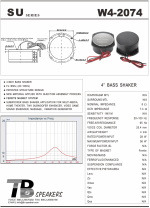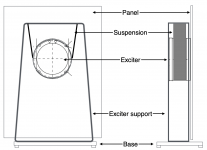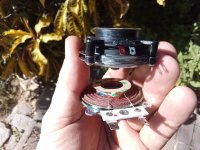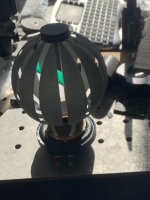Here's the same Russian showing the insides of Pioneer S-F1, which had flat panels with bass, mid, tweeter and the super tweeter in the same plane. Subtitles available.

The larger outer flat surface was bass, the middle smaller one mid, the even smaller tweeter and smallest super-tweeter. Never seen or heard them.
The larger outer flat surface was bass, the middle smaller one mid, the even smaller tweeter and smallest super-tweeter. Never seen or heard them.
re: DML bass
I started look around for an old cone driver planning to take it apart when I came across what looks like a massive exciter at
Parts Express Tang Band W4-2074 Compact 4" Bass Shaker Tactile Transducer.
Frequency response 20-100 hz.
So... why not use VHB tape to attach a panel to such a "Bass Shaker", suspend it from a metal frame (kind of like my baffleless sub woofers?
Maybe one would need to fix the edges of the panel, but such a test platform could prove useful.
Just first thoughts and a sketch.
I started look around for an old cone driver planning to take it apart when I came across what looks like a massive exciter at
Parts Express Tang Band W4-2074 Compact 4" Bass Shaker Tactile Transducer.
Frequency response 20-100 hz.
So... why not use VHB tape to attach a panel to such a "Bass Shaker", suspend it from a metal frame (kind of like my baffleless sub woofers?
Maybe one would need to fix the edges of the panel, but such a test platform could prove useful.
Just first thoughts and a sketch.
Attachments
Quite astonishing engineering effort by TechnicsHere's the same Russian showing the insides of Pioneer S-F1, which had flat panels with bass, mid, tweeter and the super tweeter in the same plane. Subtitles available.
View attachment 1117474
The larger outer flat surface was bass, the middle smaller one mid, the even smaller tweeter and smallest super-tweeter. Never seen or heard them.
Pioneer’s was even better.Quite astonishing engineering effort by Technics
Burnt
I received two pair of exciters today. DAEX32Q-8 and DAEX25FHE
I have only used the 25FHE's up till now (DIY out of TV speakers excluded) so I will be able to test these two completely different styles side by side.
"The panel is sort of an enlarged dust cap" is inherent with the 25FHE's and their "brethren" open face types, unless you glue something in between I guess?
I would never consider using the 25FHE's without a spine for fear of sag. These 32Q's on the other hand seem like they were made for this application as the 8 tension springs would prevent any sag from just the weight of the exciter. These springs are pretty stiff so I am going to use a spine regardless to ensure more thrust is transferred to the panel material.
I tried dismantling a 32Q to see if it could be reverted to bare minimum like the 25FHE pictured but seems to be glued to the plastic part underneath. These thing have a nice robust rubber boot as well like they were made for outdoor applications.
I'll soon be making a pair of rear surrounds out of dense EXP and will do the side by side tests to see if these stiff springs hold back performance in any way, that's why I wanted to try one stripped down. The small plastic spacer between the springs can be removed to use only the springs nearest the panel at least.
Well, we'll see, I guess they designed it that way for a reason.
I have only used the 25FHE's up till now (DIY out of TV speakers excluded) so I will be able to test these two completely different styles side by side.
"The panel is sort of an enlarged dust cap" is inherent with the 25FHE's and their "brethren" open face types, unless you glue something in between I guess?
I would never consider using the 25FHE's without a spine for fear of sag. These 32Q's on the other hand seem like they were made for this application as the 8 tension springs would prevent any sag from just the weight of the exciter. These springs are pretty stiff so I am going to use a spine regardless to ensure more thrust is transferred to the panel material.
I tried dismantling a 32Q to see if it could be reverted to bare minimum like the 25FHE pictured but seems to be glued to the plastic part underneath. These thing have a nice robust rubber boot as well like they were made for outdoor applications.
I'll soon be making a pair of rear surrounds out of dense EXP and will do the side by side tests to see if these stiff springs hold back performance in any way, that's why I wanted to try one stripped down. The small plastic spacer between the springs can be removed to use only the springs nearest the panel at least.
Well, we'll see, I guess they designed it that way for a reason.
Attachments
Last edited:
I thought I had an aluminium biscuit box somewhere, as I couldn't find it, the next best thing was a plastic lunchbox. 29cm x 19cm x 7.5cm deep. First I fixed the exciter to the middle of the cover listened how it worked without closing the lid.

The sound was quite horrible. Then I closed the lid placed it vertically, the sound became much better.

Then, I put two winter scarves inside the lunchbox, closed it and sound became full and nice and with bass coming out of the box. Sound just ballooned out. Even my wife liked the sound. It was not perfect, but it was quite alright.



I thought maybe, I'd put two exciters side by side, from two stereo channels, it might be good. No, not really. The two exciters sort of clashed with each other in that small plastic box. So, I removed one exciter from the box and the amp, and listened to the closed damped lunchbox for a while. Well, the while became nearly an hour. One thing is clear, a boxed, damped exciter would give out good full sound and quite good bass. The only difference is that the box's front panel would give out the sound. And the box can be bass-reflexed. Or that panel could be fixed to a surround, like Sony and Technics did. Anyway, all that have to wait until the late spring, and that's the worst part. 🙂
The sound was quite horrible. Then I closed the lid placed it vertically, the sound became much better.
Then, I put two winter scarves inside the lunchbox, closed it and sound became full and nice and with bass coming out of the box. Sound just ballooned out. Even my wife liked the sound. It was not perfect, but it was quite alright.
I thought maybe, I'd put two exciters side by side, from two stereo channels, it might be good. No, not really. The two exciters sort of clashed with each other in that small plastic box. So, I removed one exciter from the box and the amp, and listened to the closed damped lunchbox for a while. Well, the while became nearly an hour. One thing is clear, a boxed, damped exciter would give out good full sound and quite good bass. The only difference is that the box's front panel would give out the sound. And the box can be bass-reflexed. Or that panel could be fixed to a surround, like Sony and Technics did. Anyway, all that have to wait until the late spring, and that's the worst part. 🙂
Nice!Here is my latest true Omi Transducer using a PUI ASX05404-HDR 4 OHM. The 76 mm segmented sphere is polypropylene plastic with a 0.5mm wall thickness. I will also be trying a carbon fiber and acrylic resin to see which gives the best FR
Tell us about how you did that, and why. How the sound goes out from the segmented sphere?
We can make free floating large panels making music, but most probably won't be allowed in the living room. They are not very aesthetic either, so it is mostly basement, garage or some shed. Well, @aagas is lucky to have a loft. I was pondering for a while, how to make the DML (or whatever) look nice, and lately found this boxed DML or APM -- accurate pistonic motion. If the idea is to have a flat panel to give out the music, and if it can be made smaller, and boxed in such way, it might be high WAF, then why not?
I once saw Technics SB-X speakers, but never saw the Sony APMs or heard them, except on youtube. Those days, I didn't care much. From these companies, and from Hitachi, I found three ways to transform a normal old working boxed speaker to a flat panel speaker, that is, at least the bass and mid drivers.
1) Paste a aluminium honeycomb disk to the surround over the cone, cut the cone off, paste a cut-off plastic or metal funnel to the voice coil top and to the disk. Make some holes on the sides of the funnel before gluing them. (Sony and Technics) Work sequence can diffeer.
2) Instead of the funnel, use 4 to 8 aluminium rods to transfer the vibrations to the disk. This is going to be very troublesome work. (Sony) Not for me.
In both cases, if the system won't give you the desired result, you are with a damaged driver.
3) Fill the cone area with light foam isolating material somewhat tightly, and then glue the foam (aluminium) disk to the surround over the cone plus isolating foam. This was something Hitachi had found even before Sony or Technics. HS-10000 or HS-5000 in 1976 or before. Twitter too is filled with foam.
In this case, you won't be damaging the driver, if the system didn't give the desired result.
Lo-D HS5000 Translated from Japanese
Lo-D HS-90F video in Russian.
I once saw Technics SB-X speakers, but never saw the Sony APMs or heard them, except on youtube. Those days, I didn't care much. From these companies, and from Hitachi, I found three ways to transform a normal old working boxed speaker to a flat panel speaker, that is, at least the bass and mid drivers.
1) Paste a aluminium honeycomb disk to the surround over the cone, cut the cone off, paste a cut-off plastic or metal funnel to the voice coil top and to the disk. Make some holes on the sides of the funnel before gluing them. (Sony and Technics) Work sequence can diffeer.
2) Instead of the funnel, use 4 to 8 aluminium rods to transfer the vibrations to the disk. This is going to be very troublesome work. (Sony) Not for me.
In both cases, if the system won't give you the desired result, you are with a damaged driver.
3) Fill the cone area with light foam isolating material somewhat tightly, and then glue the foam (aluminium) disk to the surround over the cone plus isolating foam. This was something Hitachi had found even before Sony or Technics. HS-10000 or HS-5000 in 1976 or before. Twitter too is filled with foam.
In this case, you won't be damaging the driver, if the system didn't give the desired result.
Lo-D HS5000 Translated from Japanese
Lo-D HS-90F video in Russian.
Attachments
Last edited:
chdsl,
The segmented spheres are fabricated by SLS (Selected Laser Sintering) which is a self-supporting 3D printing process. For the acrylic spheres I use Laser Lithography, which forms the segmented spheres in a vat of photo-polymer. The maximum size for both processes is 300mm.
So far the sound is really quite spectacular in the mid-bass to mid-treble my hearing drops off around 12KHz- 13KHz. It is really quite airy and the music seems to come from everywhere much different from the planar speakers. I hope to get REW measurements before the end of the month.
I am putting these on top of a bass pedestal that has a ported 6" woofer. This should cover the 40Hz to 400Hz and the spheres I have at 400Hz -20KHz if the exciters can go that high....
The segmented spheres are fabricated by SLS (Selected Laser Sintering) which is a self-supporting 3D printing process. For the acrylic spheres I use Laser Lithography, which forms the segmented spheres in a vat of photo-polymer. The maximum size for both processes is 300mm.
So far the sound is really quite spectacular in the mid-bass to mid-treble my hearing drops off around 12KHz- 13KHz. It is really quite airy and the music seems to come from everywhere much different from the planar speakers. I hope to get REW measurements before the end of the month.
I am putting these on top of a bass pedestal that has a ported 6" woofer. This should cover the 40Hz to 400Hz and the spheres I have at 400Hz -20KHz if the exciters can go that high....
Are there 12 leaves in that segmented sphere? What is the width of the leaf at the middle, it's thickness? What is the height, or diameter of the segmented sphere? Do their tips touch the voice coil top separately, or fixed to a circle, then that circle fixed to the voice coil? Lot of questions. 🙂chdsl,
The segmented spheres are fabricated by SLS (Selected Laser Sintering) which is a self-supporting 3D printing process. For the acrylic spheres I use Laser Lithography, which forms the segmented spheres in a vat of photo-polymer. The maximum size for both processes is 300mm.
So far the sound is really quite spectacular in the mid-bass to mid-treble my hearing drops off around 12KHz- 13KHz. It is really quite airy and the music seems to come from everywhere much different from the planar speakers. I hope to get REW measurements before the end of the month.
I am putting these on top of a bass pedestal that has a ported 6" woofer. This should cover the 40Hz to 400Hz and the spheres I have at 400Hz -20KHz if the exciters can go that high....
The way I see it, the vibrations are transferred from the voice coil to the leaves from a point upwards or at an angle, which travels along it expanding, then decreasing to the top. Do you hear any sound coming out of the top disk? Is this the idea?
Last edited:
Hi all,
I am absolutely new to DMLs but I am allways fascinated by unusual concepts.
I have read all of the posts of this thread so I have a rough idea what you are talking about.
I just ordered 4 of Dayton DAEX25FHE-4.
I see that it is possible to go fullrange if the panel is big enough. One exception seems to be the canvas panel. The allready build panels show, though very small, output into bass regions.
What makes me wonder now is that no one tried some bigger canvas panels.
shouldn‘t canvas panels of 40x60 or even 40x80 give even more solid bass response? this bigger sizes are still small DML panels.
I can get two canvas frames in 36x90.
Does anythin speak against using these?
best regards
Spassgeneral
I am absolutely new to DMLs but I am allways fascinated by unusual concepts.
I have read all of the posts of this thread so I have a rough idea what you are talking about.
I just ordered 4 of Dayton DAEX25FHE-4.
I see that it is possible to go fullrange if the panel is big enough. One exception seems to be the canvas panel. The allready build panels show, though very small, output into bass regions.
What makes me wonder now is that no one tried some bigger canvas panels.
shouldn‘t canvas panels of 40x60 or even 40x80 give even more solid bass response? this bigger sizes are still small DML panels.
I can get two canvas frames in 36x90.
Does anythin speak against using these?
best regards
Spassgeneral
The larger the canvas becomes it will have less tension. Its like a drum,you will need to have the right tension for a given frequency response.Hi all,
I am absolutely new to DMLs but I am allways fascinated by unusual concepts.
I have read all of the posts of this thread so I have a rough idea what you are talking about.
I just ordered 4 of Dayton DAEX25FHE-4.
I see that it is possible to go fullrange if the panel is big enough. One exception seems to be the canvas panel. The allready build panels show, though very small, output into bass regions.
What makes me wonder now is that no one tried some bigger canvas panels.
shouldn‘t canvas panels of 40x60 or even 40x80 give even more solid bass response? this bigger sizes are still small DML panels.
I can get two canvas frames in 36x90.
Does anythin speak against using these?
best regards
Spassgeneral
Spassgeneral,
I defer to Spedge on canvas panels, regarding him as the ultimate authority on them. I merely copied his plans, and my auditory range is very limited in the higher frequencies (<8kHz), plus roaring tinnitus. In fact, I have temporarily retired my panels because of amplifier problems and too many other irons in my fire. Speak with him. He is very knowledgeable and quick to help.
I defer to Spedge on canvas panels, regarding him as the ultimate authority on them. I merely copied his plans, and my auditory range is very limited in the higher frequencies (<8kHz), plus roaring tinnitus. In fact, I have temporarily retired my panels because of amplifier problems and too many other irons in my fire. Speak with him. He is very knowledgeable and quick to help.
@tagis,
Here is the pdf file of that video. The points 4 and 5 are simply wrong. In the point 4, it appears that any object that bends and releases don't send sound waves. Sound vibrations have to travel through high density aluminium leaves from the voice coil to transport vibrations trough air, the low-density medium. The point 5, well... The sound is radiated like a balloon from a conventional speaker. 🙂
Anyway, here's how the woofer was made.
And, here's that Indian chap playing with two plastic funnels.
It is all about an up-firing voice coil transporting electrical/musical vibrations to a cut up vertical membrane. In this sort of at an angle, but the edge touching the voice coil is horizontal over the voice coil top. What is assumed here is that every point on the top of the voice coil vibrates the same, and a membrane cut up like a flower would give out sound to whichever direction the petals points to. Sony, for example, didn't cut the cylinder, just put 3 tiny actuators under, and you get a room filling music from a Bluetooth speaker, and that for $250 atm. By the way, anyone in the DIY community can do that too, very much cheaper...with a drinking glass.
Anyway, these aluminium, or plastic petals/leaves are vertical DMLs, and nice to experiment with. Looking forward to hear from you.
Here is the pdf file of that video. The points 4 and 5 are simply wrong. In the point 4, it appears that any object that bends and releases don't send sound waves. Sound vibrations have to travel through high density aluminium leaves from the voice coil to transport vibrations trough air, the low-density medium. The point 5, well... The sound is radiated like a balloon from a conventional speaker. 🙂
Anyway, here's how the woofer was made.
And, here's that Indian chap playing with two plastic funnels.
It is all about an up-firing voice coil transporting electrical/musical vibrations to a cut up vertical membrane. In this sort of at an angle, but the edge touching the voice coil is horizontal over the voice coil top. What is assumed here is that every point on the top of the voice coil vibrates the same, and a membrane cut up like a flower would give out sound to whichever direction the petals points to. Sony, for example, didn't cut the cylinder, just put 3 tiny actuators under, and you get a room filling music from a Bluetooth speaker, and that for $250 atm. By the way, anyone in the DIY community can do that too, very much cheaper...with a drinking glass.
Anyway, these aluminium, or plastic petals/leaves are vertical DMLs, and nice to experiment with. Looking forward to hear from you.
- Home
- Loudspeakers
- Full Range
- A Study of DMLs as a Full Range Speaker




